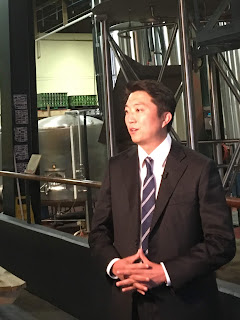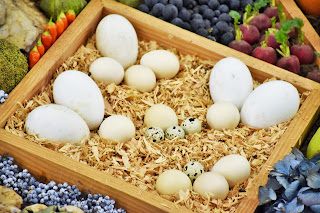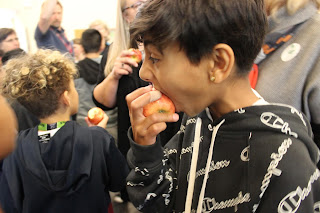Communications
 |
| WSDA Director Derek Sandison presents retiring Central Washington State Fair Manager Greg Stewart with the Director's Citation Award. |
This year, after almost a half century with the fair, Steward announced his retirement as the fair’s general manager.
With his hit song, McLean evoked and payed tribute to a transformative era in music.
Likewise, it’s only fitting that with Stewart’s retirement, we take time to celebrate the man who helped transform the fair from a small, annual event to a year-round venue for wide-ranging events and continued to encourage kids to get involved and excited about agriculture.
Last week, WSDA Director Derek Sandison presented Stewart with the Director's Citation Award.
 |
| A patriotic spread of Washington produce at the fair. |
And through it all, Stewart never forgot where it all started.
"Greg made sure this fair stayed true to its agricultural roots and promoted agriculture as a core function,” Sandison said.
Stewart’s history and achievements are well known to most anyone who has been a part of the Central Washington State Fair. His impressive record and has resulted in the betterment of fairs not only in Washington, but across the entire fair industry.
Shortly after hiring Stewart in 1972, the Central Washington Fair Association promoted him to general manager of what was then a five-day fair, overseeing a fulltime staff of three people.
A lot has changed over those 48 years.
The Central Washington State Fair and the 120-acre fairgrounds, now known as State Fair Park, have grown considerably. The fair is now a ten-day event recognized as one of the premiere events in the Northwest. Fulltime employment has grown to 22 people who help oversee and accommodate some 222 annual event days.
From the small fair he took on 48 years ago, Stewart has built an entertainment hub for the entire region.
Stewart oversaw management of the Yakima Valley SunDome located at State Fair Park. The 8,000-seat SunDome, is a $20 million multi-purpose facility now home to concerts, rodeos, and numerous other events throughout the year.
He also oversaw the management of Yakima County Stadium which opened at State Fair Park in 1993. In 2014, Yakima County Stadium became the new home to the Yakima Valley Pippins, a West Coast League baseball team.
In 2000, the former Yakima Meadows horse race track located on the grounds was turned into a three-eighths-mile racetrack, now called State Fair Raceway. The all-clay racetrack is used for sprint car and dirt-track car racing.
Stewart was also director and vice president of the Western Fairs Association 1979-1981 and a Hall of Fame recipient in 1995. He was the first recipient outside of California to be on the Western Fairs Association Board and to receive the Hall of Fame award.
 |
| Come one! Come all! Come tall! |
Stewart has been pivotal in establishing relationships with the Hispanic and Native American communities. In 2018, he helped Yakima create a Sister City partnership with Hadong, South Korea and their Green Tea Festival.
Born and raised in Olympia, Stewart attended Centralia College in 1963 and graduated from Washington State University with a degree in agricultural economics. He served in the U. S. Army 1966-1969, including a tour of duty in Vietnam.
Stewart and his wife, Karen, live in Selah, and in his spare time he enjoys traveling, boating, horses, fishing, and spending time with their daughter Tami and her family.


























